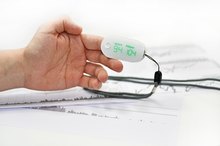What does fact checked mean?
At Healthfully, we strive to deliver objective content that is accurate and up-to-date. Our team periodically reviews articles in order to ensure content quality. The sources cited below consist of evidence from peer-reviewed journals, prominent medical organizations, academic associations, and government data.
- “Critical Care”; Pulse Oximetry; Amal Jubran; May 1999
- “Critical Care”; Pulse Oximetry; Amal Jubran; May 1999
- MedlinePlus: Hemoglobin Derivatives
The information contained on this site is for informational purposes only, and should not be used as a substitute for the advice of a professional health care provider. Please check with the appropriate physician regarding health questions and concerns. Although we strive to deliver accurate and up-to-date information, no guarantee to that effect is made.
Oxygen is transported from the lungs to the tissues of the body by hemoglobin. A pulse oximeter is a device that attaches to the skin and uses light wavelengths to measure the percentage of hemoglobin molecules carrying oxygen. Pulse oximetry may be used as an indirect marker of blood oxygen levels, but some important disadvantages need be considered.
Limited Range of Precision
A wide variety of pulse oximeter models are available from several different manufacturers. A comprehensive 1999 review of pulse oximeters published in “Critical Care” noted that, on average, oximeters are accurate within 2 percent for oxygen saturations of 90 percent or more 1. Oximeters are far less reliable, however, once the oxygen saturation falls below 80 percent.
Ineffective in Poor Perfusion States
Normal Oxygen Levels Using a Pulse Oximeter
Learn More
Pulse oximetry works by measuring the amount of oxygenated hemoglobin in the blood. It does not, however, detect whether or not enough blood is actually moving through the tissues. In states of low perfusion, such as shock, hypothermia and vasoconstriction, the oximeter probe may read a normal hemoglobin saturation level even though there is not enough blood moving through the area.
Ineffective in Anemia
When hemoglobin levels in the blood are low due to anemia, or loss of red blood cells, the pulse oximeter is not an accurate measurement of blood oxygen levels. The existing hemoglobin molecules may all be filled with oxygen, giving a high oximeter reading, but there are not enough hemoglobin molecules to carry the needed oxygen to the tissues.
Carboxyhemoglobin and Methemoglobin Interference
How to Use a Finger Pulse Oximeter
Learn More
Carboxyhemoglobin is hemoglobin bound to carbon monoxide, a dangerous gas produced by things like fires and malfunctioning furnaces. It binds to hemoglobin irreversibly and prevents oxygen from binding. Methemoglobin is another type of altered hemoglobin that occurs with certain medications and medical conditions.
Color Interference
Because the pulse oximeter works by sensing light wavelengths, anything that interferes with the light spectrum can prevent proper functioning of the sensor. Pulse oximeters are commonly placed on fingers or toes, and things like false nails or nail polish can interfere with the light sensor. These problems can be overcome by attaching the sensor to an earlobe or, on children and smaller persons, around the wrist. Intravenous dyes used in medical imaging studies can also interfere with the light wavelengths.
- Because the pulse oximeter works by sensing light wavelengths, anything that interferes with the light spectrum can prevent proper functioning of the sensor.
- Pulse oximeters are commonly placed on fingers or toes, and things like false nails or nail polish can interfere with the light sensor.
Skin Pigmentation
Similar to interference from colors applied to the skin or fingernails, skin pigmentation may also interfere with a pulse oximeter. A 2007 study in “Anesthesia and Analgesia” confirmed previous reports that a pulse oximeter is more likely to overestimate the oxygen concentration at low saturations in individuals with darker skin.
Motion Sensitivity
When a patient vigorously moves the extremity that the oximeter sensor it attached to, it can interfere with the wavelength signals and cause the oximeter to sound the low oxygen alarm.
Related Articles
References
- “Critical Care”; Pulse Oximetry; Amal Jubran; May 1999
- MedlinePlus: Hemoglobin Derivatives
- “American Journal of Critical Care”; New-Generation Pulse Oximetry in the Care of Critically Ill Patients; Karen K. Giuliano, R.N., Ph.D. and Thomas L. Higgins, M.D., MBA; 2005
- Plüddemann A, Thompson M, Heneghan C, Price C. Pulse oximetry in primary care: primary care diagnostic technology update. Br J Gen Pract. 2011;61(586):358–359. doi:10.3399/bjgp11X572553
- Shah SA, Velardo C, Farmer A, Tarassenko L. Exacerbations in Chronic Obstructive Pulmonary Disease: Identification and Prediction Using a Digital Health System. J Med Internet Res 2017;19(3):e69.
- Vold ML, Aasebø U, Wilsgaard T, Melbye H. Low oxygen saturation and mortality in an adult cohort: the Tromsø study. BMC Pulm Med. 2015;15:9. Published 2015 Feb 12. doi:10.1186/s12890-015-0003-5
- Pandya NK, Sharma S. Capnography And Pulse Oximetry. [Updated 2020 Jan 30]. In: StatPearls [Internet]. Treasure Island (FL): StatPearls Publishing; 2020 Jan-. Available from: https://www.ncbi.nlm.nih.gov/books/NBK539754/
- Castro D, Keenaghan M. Arterial Blood Gas. [Updated 2020 Feb 20]. In: StatPearls [Internet]. Treasure Island (FL): StatPearls Publishing; 2020 Jan-. Available from: https://www.ncbi.nlm.nih.gov/books/NBK536919/
- Torp KD, Simon LV. Pulse Oximetry. [Updated 2019 Apr 28]. In: StatPearls [Internet]. Treasure Island (FL): StatPearls Publishing; 2020 Jan-. Available from: https://www.ncbi.nlm.nih.gov/books/NBK470348/
- Johns Hopkins University Medicine. Pulse Oximetry. 2019.
- Shah SA, Velardo C, Farmer A, Tarassenko L. Exacerbations in Chronic Obstructive Pulmonary Disease: Identification and Prediction Using a Digital Health System. J Med Internet Res. 2017;19(3):e69. Published 2017 Mar 7. doi:10.2196/jmir.7207
- Shah SA, Velardo C, Farmer A, Tarassenko L. Exacerbations in Chronic Obstructive Pulmonary Disease: Identification and Prediction Using a Digital Health System. Eysenbach G, ed. Journal of Medical Internet Research. 2017;19(3):e69. doi:10.2196/jmir.7207
- Fahy B, Lareau S, Sockrider M. Pulse Oximetry. American Journal of Respiratory and Critical Care Medicine. American Thoracic Society. 2011;184: 1.
Writer Bio
Amy O'Connell is a writer who has published research in scientific journals such as "Infection and Immunity." Her areas of expertise include allergies, conditions in children and celiac disease. She has a Ph.D. in immunology and a medical degree from Thomas Jefferson University in Philadelphia.









